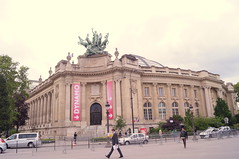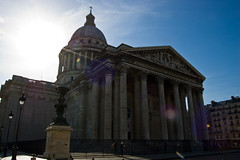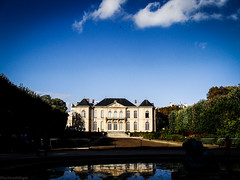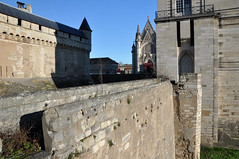Île-de-France
The Île-de-France (English: /ˌl_də_ˈfrs/, French: [il də fʁɑ̃s]; literally "Isle of France") is the most populous of the eighteen regions of France, with an official estimated population of 12,271,794 residents on January 1, 2023. Centred on the capital Paris, it is located in the north-central part of the country and often called the Paris Region (French: Région parisienne, French: [ʁeʒjɔ̃ paʁizjɛn]). Île-de-France is densely populated and retains a prime economic position on the national stage: though it covers only , about 2% of metropolitan French territory, its 2017 population was nearly one-fifth of the national total.
The region is made up of eight administrative departments: Paris, Essonne, Hauts-de-Seine, Seine-Saint-Denis, Seine-et-Marne, Val-de-Marne, Val-d'Oise and Yvelines. It was created as the "District of the Paris Region" in 1961. In 1976, when its status was aligned with the French administrative regions created in 1972, it was renamed after the historic province of Île-de-France. Residents are sometimes referred to as Franciliens, an administrative word created in the 1980s. The GDP of the region in 2019 was nearly one-third of the French, and 5% of the European Union's. It has the highest per capita GDP of any French region and the third highest of any region in the European Union.
Beyond the city limits of Paris, the region has many other important historic sites, including the palaces of Versailles and Fontainebleau, as well as the most-visited tourist attraction in France, Disneyland Paris. Though it is the richest French region, a significant number of residents live in poverty: the official poverty rate in the Île-de-France was 15.9% in 2015. The region has witnessed increasing income inequality in recent decades and rising housing prices have pushed the less affluent outside Paris.
Etymology
Although the modern name Île-de-France literally means "Island of France", its etymology is in fact unclear. The "island" may refer to the land between the rivers Oise, Marne and Seine, or it may also have been a reference to the Île de la Cité, where the French royal palace and cathedral were located.
Alternatively, the name may refer to the lands that were under the direct rule of the Capetian kings during the Middle Ages; thus, the lands were an "island" in a sea of various feudal territories ruled by vassals of the king.
History
The Île-de-France was inhabited by the Parisii, a sub-tribe of the Celtic Senones, from around the middle of the 3rd-century BC. One of the area's major north–south trade routes crossed the Seine on the île de la Cité; the meeting place of land and water trade routes gradually became an important trading centre. The Parisii traded with many river towns (some as far away as the Iberian Peninsula) and minted their own coins for that purpose.
The Romans conquered the area in 52 BC and began their settlement on Paris's Left Bank. It became a prosperous city with a forum, baths, temples, theatres, and an amphitheatre. Christianity was introduced in the middle of the 3rd century AD by Saint Denis, the first Bishop of Paris. According to legend, when Denis refused to renounce his faith before Roman authorities, he was beheaded on the hill that became known as Mons Martyrum (Latin "Hill of Martyrs"), later "Montmartre". The legend further states that Denis walked headless from this hill to the north of the city. The place that he finally fell and was buried became an important religious shrine, the Basilica of Saint-Denis.
Clovis the Frank, the first king of the Merovingian dynasty, made the city his capital in 508. As the Frankish domination of Gaul began, there was a gradual immigration by the Franks to Paris and the Parisian Francien dialects were born. Fortification of the Île de la Cité failed to avert sacking by Vikings in 845, but Paris's strategic importance—with its bridges preventing ships from passing—was established by successful defence in the Siege of Paris (885–86). In 987, Hugh Capet, Count of Paris (comte de Paris) and Duke of the Franks (duc des Francs), was elected King of the Franks (roi des Francs). Under the rule of the Capetian kings, Paris gradually became the largest and most prosperous city in France.
The Kings of France enjoyed getting away from Paris and hunting in the game-filled forests of the region. They built palatial hunting lodges, most notably Palace of Fontainebleau and the Palace of Versailles. From the time of Louis XIV to the French Revolution, Versailles was the official residence of the Kings and the seat of the French government. Île-de-France became the term used for the territory of Paris and the surrounding province, which was administered directly by the King.
During the French Revolution, the royal provinces were abolished and divided into departments, and the city and region were governed directly by the national government. After World War II, as Paris faced a major housing shortage, hundreds of massive apartment blocks for low-income residents were built around the edges of Paris. In the 1950s and the 1960s, thousands of immigrants settled in the communes bordering the city. In 1959, under President Charles De Gaulle, a new region was created out of six departments, which corresponded approximately with the historic region, with the name District de la région de Paris ("District of the Paris Region"). On 6 May 1976, as part of the process of regionalisation, the district was reconstituted with increased administrative and political powers and renamed the Île-de-France region.
Geography
Île-de-France is in the north of France, neighboring Hauts-de-France to the north, Grand Est to the east, Bourgogne-Franche-Comté to the southeast, Centre-Val-de-Loire to the southwest, and Normandy to the west.
Departments
Île-de-France has a land area of . It is composed of eight departments centred on its innermost department and capital, Paris. Around the department and municipality of Paris, urbanisation fills a first concentric ring of three departments commonly known as the petite couronne ("small ring"); it extends into a second outer ring of four departments known as the grande couronne ("large ring"). The former department of Seine, abolished in 1968, included the city proper and parts of the petite couronne.
The petite couronne consists of the departments of Hauts-de-Seine, Seine-Saint-Denis and Val-de-Marne; the grande couronne consists of those of Seine-et-Marne, Yvelines, Essonne and Val-d'Oise. Politically, the region is divided into 8 departments, 25 arrondissements, 155 cantons and 1,276 communes, out of the total of 35,416 in metropolitan France.
Topography
The outer parts of the Île-de-France remain largely rural. Agricultural land, forest and natural spaces occupy 78.9 percent of the region, and 28 percent of the region's land is in urban use. the remaining 24 percent is rivers, forests, woods, and ponds.
The River Seine flows through the middle of the region, which is crisscrossed by its tributaries and sub-tributaries, including the Rivers Marne, Oise and Epte. The River Eure does not cross the region but receives water from several rivers in the Île-de-France, including the Drouette and the Vesgre. The major rivers are navigable, and, because of the modest variations of altitude in the region (between 10 and 200 meters), they have a tendency to meander and curve. They also create many lakes and ponds, some of which have been transformed into recreation areas, including Moisson-Mousseaux, Cergy-Neuville and Villeneuve-Saint-Georges.
Tourism
The Île-de-France is one of the world's top tourist destinations, with a record 23.6 million hotel arrivals in 2017, and an estimated 50 million visitors in all types of accommodation. The largest number of visitors came from the United States, followed by England, Germany and China. The top tourist attraction in the region in 2017 was Disneyland Paris, which received 14.8 million visitors in 2017, followed by the Cathedral of Notre-Dame (est. 12 million) and the Basilica of Sacre-Coeur at Montmartre (est. 11.1 million visitors).
Notable historic monuments in the Region outside of Paris include the Palace of Versailles (7,700,000 visitors), the Palace of Fontainebleau (500,000 visitors), the chateau of Vaux-le-Vicomte (300,000 visitors), and the Château de Malmaison, Napoleon's former country house; and the Basilica of Saint-Denis, where the Kings of France were interred before the French Revolution.
Demographics
Population density
, the population density of the region was 1010.9 inhabitants per square kilometer. The densest department is Paris itself, with 21,066 inhabitants per square kilometer. The least dense département is Seine-et-Marne with 239 residents per square kilometer.
Wealth and poverty
according to the official government statistics agency INSEE, 15.9 percent of residents of the region had an income below the poverty level; for residents of the city of Paris, this proportion was 16.2 percent. Poverty was highest in the departments of Seine-Saint-Denis (29 percent), Val-d'Oise (17.1 percent), and Val-de-Marne (16.8 percent). It was lowest in Yvelines (9.7 percent); Seine-et-Marne (11.8 percent), Essonne (12.9 percent), and Hauts-de-Seine (12.4 percent). The department of Hauts-de-Seine is the wealthiest in France in terms of per capita GDP.
Immigration
At the 2019 census, 75.1% of the inhabitants of Île-de-France were natives of Metropolitan France, 1.7% were born in Overseas France, and 23.1% were born in foreign countries. A quarter of the immigrants living in the Île-de-France were born in Europe (38% of whom in Portugal), 29% were born in the Maghreb and 22% in the rest of Africa (in particular West and Central Africa), 3% were born in Turkey and 15% in the rest of Asia, 5% were born in the Americas (not counting those born in the French overseas departments in the Americas, who are not legally immigrants), and 0.1% in Oceania (not counting those born in the French territories of the South Pa…
Hotels Île-de-France
 citizenM Paris Gare de LyonParis
citizenM Paris Gare de LyonParis B&B HOTEL Saint-Denis Porte de ParisSaint-Denis
B&B HOTEL Saint-Denis Porte de ParisSaint-Denis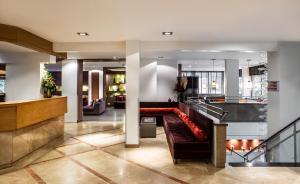 Hotel Paris BoulogneBoulogne-Billancourt
Hotel Paris BoulogneBoulogne-Billancourt Adagio Serris Val d EuropeSerris
Adagio Serris Val d EuropeSerris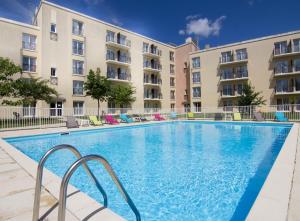 Résidence Du Parc Val d'EuropeMontévrain
Résidence Du Parc Val d'EuropeMontévrain Appartements - Le Logis VersaillaisVersailles
Appartements - Le Logis VersaillaisVersailles MOB HOTEL Paris Les PucesSaint-Ouen
MOB HOTEL Paris Les PucesSaint-Ouen Relais Spa Chessy Val d'EuropeChessy
Relais Spa Chessy Val d'EuropeChessy
Looking for places related to Île-de-France?
Those are other destinations to find places related to Île-de-France:










